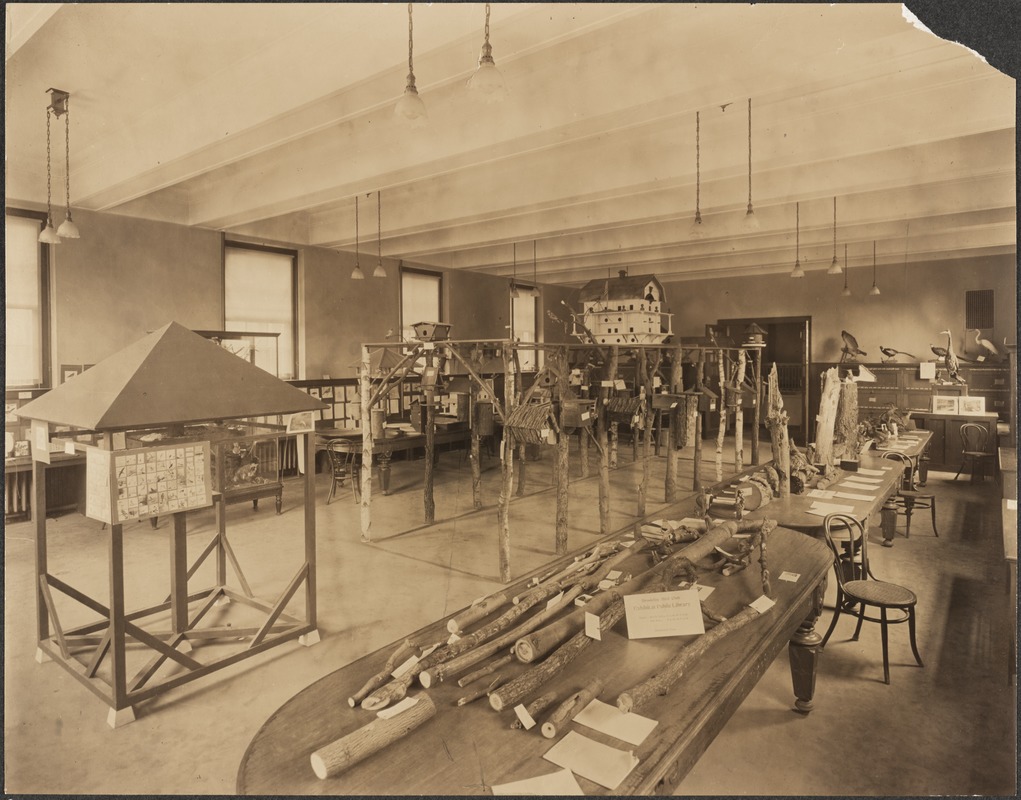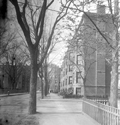 |
The Fisk Hospital, 106 Sewall St.
"For the treatment of Alcoholism and Drug Addiction (By the Towns-Lambert Method)
Private Rooms – Competent Physicians – Trained Nurses
|
 |
Free Hospital for Women
Looking from Leverett Pond; built 1894-1895
|
 |
Free Hospital for Women, circa 1910
|
 |
Nurses House, Free Hospital For Women, 1912
|
 |
39 Irving St., Before 1890
Upland Rd. is to the right of the house followed by a partial view of 43 Upland Rd., both houses are still standing. None of the houses that were constructed in the rear on Upland Rd. beginning in 1890 are present.
[Source: Brookline Preservation Department]
|
 |
65 Kent St., Rear, January 1966
This substantial brick building was torn down in 1974 as the “Marsh Urban Renewal Project” was entering its core phase. Its removal accommodated the addition of a few additional feet for the covered parking platform straddling the tracks that remains today.
In the distance o the right is 74 Kent St. The large smoke stack of Brannen’s Laundry had been there for 75 years and was even considered to be an historic landmark of sorts when it had to be torn down in 1980.
From a notebook of property-appraisal photos taken in 1965 and early 1966 for “The Marsh Urban Renewal Project” run by the Brookline Redevelopment Authority. Only a few scattered peripheral structures remain today.
|
 |
Brookline Bird Club Exhibition, 1914
This is an exhibition of the Brookline Bird Club and the town forestry department held at the library in April 1914.
[Source: Digital Commonwealth]
|
 |
Public Library, 1940
|
 |
Carlton St. at Monmouth St., circa 1910
Lookng north from Monmouth St. The apartment building at 40 Carlton St. on the northwest corner has not yet been erected (1924).
|
 |
Hawes St., circa 1910
Looking south. Monmouth St. coming in on the left followed by the George Wightman mansion (b. 1904) at 43 Hawes St.. 48 Hawes St. (b. 1913) visible on the right. Both still standing.
|
 |
Kent St., circa 1910
Looking south toward Longwood Ave. In the foreground on the left is 116 Colchester St. followed by 295 Kent St. Far in the distance, the rounded entrance to 269 Kent St. can be detected on the southeast corner of Longwood Ave. The latter two houses remain unchanged.
116 Colchester St. was sold in 1906 and the 1907 atlas indicates that the wooden siding shown in the photo was replaced by stucco. The current configuration is entirely different, it is unknown whether that is the result of a subsequent extensive enlargement or a complete replacement.
|
 |
Future Site of the Hearthstone Plaza, August 1965
Looking southwest from the Brookline Village “T” stop at what is essentially today’s Hearthstone Plaza. These buildings, save those in the center on the south side of Lower Washington St., were razed in the next 2-3 years for the Plaza project. From left to right:
- Partial view of the rear wall of the movie theater at 105 Washington St.
- Partial view of the rear of the four-story apartment building at 127-131Washington St.
- The fire station and buildings on High St. south of Lower Washington St. which still stand
- The buildings from 137-175 Washington St.
From a notebook of property-appraisal photos taken in 1965 and early 1966 for “The Marsh Urban Renewal Project” run by the Brookline Redevelopment Authority. Only a few scattered peripheral structures remain today.
|
 |
Lower Washington St., August 1965
Looking at the north side of Lower Washington St. prior to the start of the urban renewal project for the area known as “The Marsh”. In the center is the building at 127-131 Washington St. housing Sagamore Liquors on the left and The Village restaurant on the right. The large open space on the left had been the site of a wooden building from the 1800s known as “Russell Block”. In August 1962 the town ordered that it be demolished due to its dilapidated condition and no attempt was made to replace it with the urban renewal project pending. On the right is the building built in 1937 housing the entrance to the movie theater.
From a notebook of property-appraisal photos taken in 1965 and early 1966 for “The Marsh Urban Renewal Project” run by the Brookline Redevelopment Authority. Only a few scattered peripheral structures remain today.
[Source: Brookline Preservation Department]
|
 |
127-131 Washington St., August 1965
Looking at the north side of Lower Washington St. prior to the start of the urban renewal project for the area known as “The Marsh”. In the center is the building at 127-131 Washington St. housing Sagamore Liquors on the left and The Village restaurant on the right. The large open space on the left had been the site of a wooden building from the 1800s known as “Russell Block”. In August 1962 the town ordered that it be demolished due to its dilapidated condition and no attempt was made to replace it with the urban renewal project pending. On the right is the building built in 1937 housing the entrance to the movie theater.
From a notebook of property-appraisal photos taken in 1965 and early 1966 for “The Marsh Urban Renewal Project” run by the Brookline Redevelopment Authority. Only a few scattered peripheral structures remain today.
|
 |
157-171 Washington St., July 1965
Looking at the north side of Lower Washington St. where the roadway becomes Boylston St. and Washington St. curves northward to the left in the photo. In one year, the Brookline Redevelopment Authority would begin the process of eminent domain to demolish all these buildings for the Hearthstone Plaza, the first phase of “The Marsh Urban Renewal Project”. From right to left:
- Jim’s Shoe Store, 157 Washington St. In the Village for three decades, the shop moved here in 1941 from its location at 139 Washington St.
- Village Barber Shop, 159 Washington St.
- Kenmore Valet, dry cleaning, 165 Washington St. They relocated to 39 Harvard St.
- Brookline Bulk Candy Co, 167 Washington St. They relocated to 216 Washington St. as “Village Candies”
- Ames Supply Co., 171 Washington St., (partial view) was one of thirteen businesses, out of 49 total in The Marsh, deemed not essential to village life and therefore not eligible for relocation by the Brookline Redevelopment Authority
From a notebook of property-appraisal photos taken in 1965 and early 1966 for “The Marsh Urban Renewal Project” run by the Brookline Redevelopment Authority. Only a few scattered peripheral structures remain today.
|
 |
Unidentified Longwood area, "Lover's Walk", 1889
|
 |
76 Sewall Ave.
Still standing.
[Source: Historic New England]
|
 |
Sewall Ave.
Looking west on Sewall Ave. from St Paul St. None of the houses on the left side remain. On the right, from right to left, all on Sewall Ave:
- #82, no longer standing
- #76 with the unique entrance, still standing
- #70 is barely differentiated from #76, it is still standing
- #64, no longer standing
- Charles St. enters, not visible
- White house
- Second Unitarian Society Parish House
[Source: Brookline Public Library]
|
 |
Sewall Ave.
Looking west just before Charles St. 64 Sewall partially viewed on the right. 65 Sewall Ave. partially viewed on the left followed by #61, none still standing.
[Source: Brookline Preservation Department]
|
 |
Construction of the Second Unitarian Society Parish House, Sewall Ave., circa 1901
The Society formed in 1896 and initially met in the Sears Chapel on Colchester St. They constructed this building, at today’s 50 Sewall Ave., and began holding services there in early 1902. Visible on the right is the S. S. Pierce building and, on the left in the far distance, the Etsy mansion on top of Aspinwall Hill. In 1916, the congregation moved to a new building next door at 11 Charles St.
[Source: Smithsonian]
|